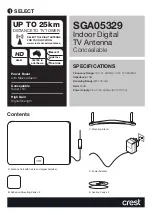
B
roadband Power Technology
,
3945
North 900 West, Pleasant View, UT 84414-1055 Ph: 801.732.0924 Fx: 801.732.0891
Website: http://www.bptec.com Email: [email protected]
8
No signal output from the antenna -
•
Using a Volt Ohm Meter (VOM), check the DC supply output at the connector. The output
voltage should be 12 VDC +/- 0.5 V. The center connection is positive.
•
Check the “To active antenna” output of the RSM-2000 +12V in the same manner as the DC
power supply. The center pin of the BNC output connector is positive. If no voltage is present,
the fuse has probably failed and must be replaced. In the event of a failed fuse in the RSM-2000
unit, replace with a Radio Shack P/N 279-1062, 0.75 A, slow-blow, 5X20 mm, GMA type.
•
Check the connector at the antenna, the center pin of the coax connector should be at 12 VDC
also. If no voltage is present and the RSM-2000 output is 12 VDC then the main RF cable may
have an intermittent condition.
If all tests indicate that the coax or antenna is at fault, please contact your distributor for replacement
parts.
In case of Intermodulation products or "Receiver Overload" -
Receiver overload will appear as hearing the same signal at several frequencies or tuner settings at the
same time. You may have to listen for a while to determine if a signal is being received at the correct
receiver frequency. In the event that you detect intermodulation effects in the receiver, the source of the
problem can be easily located. Turn the attenuator at the Interface fully counter clockwise.
•
If the level of the intermodulation image signals decrease as the attenuation is increased, even
the signal drops down, the source of overload is poor large signal handling capability of the
receiver itself.
•
If the level of the intermodulation image signals stays the same, without regard to the attenuator
setting, the source of overloading is probably due to antenna preamplifier overloading and can
not be easily corrected.
The most common reason for having intermodulation image signals produced within the antenna is the
presence of a high level signal from a local TV or FM broadcast station. These signals can be so strong,
that the preamplifier circuit operation becomes non-linear and begin to act as a mixer instead of a linear
amplifier. This mixing action causes high-level signals to mix or "beat" with other signals producing sum
and difference signals that are seen by the receiver as being real.
Relocating an antenna to a lower elevation or a location somewhat more shielded from the suspect
signals may reduce overloading. Mounting an HF vertical active antenna on the top of an antenna tower
will only slightly enhance the antenna's ability to pick up signals while increasing the risk of
intermodulation distortion effects. Mounting the antenna just above the roof of the building or above the
ground is one of the best solutions to all vertical active antennas without dramatically degrading
reception. Height is everything fro the VHF and UHF models as the signal propagation is line of site.
If signal overload appears to be the cause of your problem, please consider the possibility of upgrading to
an HDX model, which is far more tolerant of high signal areas. Low frequency signals or noise sources
can also induce common mode signals onto the coax. These signals can be coupled into your receiver
and cause intermodulation problems. Placing one or more suitable ferrite type cores onto the coax at the
base of the antenna can reduce this type of undesirable signal pickup. Please contact us for additional
information if you suspect this to be a problem in your installation.
Rev 2.8
090803


























